Ovid's Metamorphoses and Further Metamorphoses discussion
The Metamorphoses - The 15 Books
>
Book Two - 19th November 2018
 Roger wrote: "Yes, I've been toying with posting this Rembrandt myself, but there is so, so much, and this one seems especially unclassical. Which is precisely its interest, of course! It all seems so bourgeois,..."
Roger wrote: "Yes, I've been toying with posting this Rembrandt myself, but there is so, so much, and this one seems especially unclassical. Which is precisely its interest, of course! It all seems so bourgeois,..."Wonderful! The breadth of Rembrandt's reach, his ablility to subsume such a lusty, pagan episode into the realm of Dutch domesticity is almost breathtaking. That said, I wonder how (or if) Dutch schoolmasters undertook to relate the Europa story to their students!
 Jim wrote: "That said, I wonder how (or if) Dutch schoolmasters undertook to relate the Europa story to their students! "
Jim wrote: "That said, I wonder how (or if) Dutch schoolmasters undertook to relate the Europa story to their students! "How did schoolmasters relate the story to you, Jim? It's a valid question to ask of the whole Met, actually. Many of us knew, or knew of, a lot of these tales well before the age when we could fit them into the full body of adult knowledge. I knew the word "rape," for example, as something that happened in classical stories such as Proserpine or the Sabine Women, long before I knew of its sexual meaning—or the mechanics of sex, for that matter. R.
 Yes, interesting to think about how the context of our first meetings shape our understanding of both myths and the Met. I seem to have absorbed the well-known myths via a childhood of voracious reading, probably true of many of us here.
Yes, interesting to think about how the context of our first meetings shape our understanding of both myths and the Met. I seem to have absorbed the well-known myths via a childhood of voracious reading, probably true of many of us here.I first read the Met. (in the horrible Mary Innes prose translation) at 18 when it was on the list of books to read before starting uni - so it was positioned as a repository of classical stories rather than as a text in its own right. I probably didn't even know at the time that it was a poem...
My 'real' engagement with it came when I was a Classics post-grad. There is some feminist criticism from the 1980s that argues the Met. shouldn't be taught in schools/universities since it entrenches ideas about rape as female fate and masculine prerogative - but modern scholars are far more nuanced about how power circulates in the Met. and the poem's attitudes to it.
 I didn’t know the classics at all. My college included a section of Herodotus in the common core, but went no further. It was the period in the 1970s when contemporary literature was very exciting, the usable past was the Beat poets and writers, and the canon was being thrown overboard. I went on to specialize in U.S. history and modernism. Thus, I am encountering Ovid with a blank slate and enjoying all of the new knowledge.
I didn’t know the classics at all. My college included a section of Herodotus in the common core, but went no further. It was the period in the 1970s when contemporary literature was very exciting, the usable past was the Beat poets and writers, and the canon was being thrown overboard. I went on to specialize in U.S. history and modernism. Thus, I am encountering Ovid with a blank slate and enjoying all of the new knowledge.
 Historygirl wrote: "I am encountering Ovid with a blank slate and enjoying all of the new knowledge."
Historygirl wrote: "I am encountering Ovid with a blank slate and enjoying all of the new knowledge."What joy! R.
 Roman Clodia wrote: "since it entrenches ideas about rape as female fate and masculine prerogative - but modern scholars are far more nuanced about how power circulates in the Met. and the poem's attitudes to it.."
Roman Clodia wrote: "since it entrenches ideas about rape as female fate and masculine prerogative - but modern scholars are far more nuanced about how power circulates in the Met. and the poem's attitudes to it.."Interesting. I've been wondering whether Ovid was empathising with women's lot to some extent or not. The same question came up for me while reading Euripides whose main characters are often women. Were Ovid and Euripides misogynists or did they show true sympathy for women who suffered from the rigorous patriarchy by indirectly criticising male society with their poems and plays?
 Jasmine wrote: "Roman Clodia wrote: "since it entrenches ideas about rape as female fate and masculine prerogative - but modern scholars are far more nuanced about how power circulates in the Met. and the poem's a..." I see mixed messages on this subject, at some level the injustices are appreciated or at least acknowledged, even if the wrong person (the oppressed woman) is punished by the wrong god (usually female Juno). I found mixed messages in Homer's Odyssey as well, Penelope is hushed by her own son, but is directly called more competent...I look forward to the discussion of the Teiresias in book three.
Jasmine wrote: "Roman Clodia wrote: "since it entrenches ideas about rape as female fate and masculine prerogative - but modern scholars are far more nuanced about how power circulates in the Met. and the poem's a..." I see mixed messages on this subject, at some level the injustices are appreciated or at least acknowledged, even if the wrong person (the oppressed woman) is punished by the wrong god (usually female Juno). I found mixed messages in Homer's Odyssey as well, Penelope is hushed by her own son, but is directly called more competent...I look forward to the discussion of the Teiresias in book three.
 Fionnuala wrote: "Just to say I'm following the discussion with much interest — and viewing the art with great pleasure."
Fionnuala wrote: "Just to say I'm following the discussion with much interest — and viewing the art with great pleasure."Waving to Fio and echoing her sentiment.
I have finished Book II...both Simpson and Mandelbaum...and perused all of your lovely posts. All with pleasure...and wonder.
 Kalliope wrote: "I also feel that applying our morals to previous ages is a double edge blade... I prefer to stay within the analytical approach and stay away from the morals. The latter can lead also to a desire to change or censor history, which for me can have very dangerous results.
Kalliope wrote: "I also feel that applying our morals to previous ages is a double edge blade... I prefer to stay within the analytical approach and stay away from the morals. The latter can lead also to a desire to change or censor history, which for me can have very dangerous results.In Ovid I am finding the humour and the politics, that RC pointed at, more fascinating."
I wholeheartedly agree. Analyzing and revisiting history using contemporary values is a rocky and dangerous path. One that can lead to censorship and dissembling of the complex map that has led us to where we are.
Roger wrote: "We look to art to challenge, not to confirm."
Well said!
 Speaking as one of the three moderators (but a newbie in the role), I must say I am pleased by the way the discussion has been developing since Book 1, with more contributors, and a nice balance between the dedicated classicists or historians, those who are more interested in the rich legacy of Ovid, and the many (I suspect) who are just enjoying the ride. Thank you, all! Roger.
Speaking as one of the three moderators (but a newbie in the role), I must say I am pleased by the way the discussion has been developing since Book 1, with more contributors, and a nice balance between the dedicated classicists or historians, those who are more interested in the rich legacy of Ovid, and the many (I suspect) who are just enjoying the ride. Thank you, all! Roger.
 Historygirl wrote: "I didn’t know the classics at all. My college included a section of Herodotus in the common core, but went no further. It was the period in the 1970s when contemporary literature was very exciting,..."
Historygirl wrote: "I didn’t know the classics at all. My college included a section of Herodotus in the common core, but went no further. It was the period in the 1970s when contemporary literature was very exciting,..."The same is true for me...sans Herdotus. An enlightened nun introduced us to mythology and modern music when I was 14 or 15. My college years were in the 70's when we were exploring a new world and emphatically rejecting the canon. I went on to Interdiscipliary Art and Women's Studies. A lifetime lived since then has taught me both the wisdom and folly of those heady years. I, too, am approaching Ovid with a fresh mind.
 I read quite a bit of Ovid in the rather weird British private education system of the time (early 1950s), between ages 11 and 14. But the emphasis was on language, not narrative. Then I changed majors, more than once actually.
I read quite a bit of Ovid in the rather weird British private education system of the time (early 1950s), between ages 11 and 14. But the emphasis was on language, not narrative. Then I changed majors, more than once actually.I returned to Ovid indirectly in my first career as an art historian, then in my second and longer one as an opera director. As I came upon various works based on Ovid—and there are a lot of them—I would go back to the source to check. But this is my first time reading the Metamorphoses from beginning to end.
Now I am retired from all the above, but very much engaged in teaching a series of courses for seniors that combine, in various ways, art, music, and literature. So the multi-disciplinary world of the Ovid legacy is a perfect match for my current interests, and every Book is full of new discoveries. Roger.
 Roman Clodia wrote: "Yes, interesting to think about how the context of our first meetings shape our understanding of both myths and the Met. I seem to have absorbed the well-known myths via a childhood of voracious re..."
Roman Clodia wrote: "Yes, interesting to think about how the context of our first meetings shape our understanding of both myths and the Met. I seem to have absorbed the well-known myths via a childhood of voracious re..."It's reassuring to learn that I'm not the only reader who found Mary Innes' translation deadly. Presenting a prose version of poetry is as cloying to me as hearing someone recite the entire plot of a film you haven't seen. On the other hand I'm dazzled by the ability of so many translators who are able to capture the color, even in some cases the rhythm of a poem while transforming it into another language. That's why I'm prepared to forgive Golding for the liberties he took with his 1567 translation.
 Ce Ce wrote: "Fionnuala wrote: "Just to say I'm following the discussion with much interest — and viewing the art with great pleasure."
Ce Ce wrote: "Fionnuala wrote: "Just to say I'm following the discussion with much interest — and viewing the art with great pleasure."Waving to Fio and echoing her sentiment..."
Aren't we being treated to such a marvelous and continuous spectacle, Ce Ce — as if this corner of Goodreads had metamorphosed into an interactive lecture theatre/art gallery!
 Elena wrote: "Jasmine wrote: "Roman Clodia wrote: "since it entrenches ideas about rape as female fate and masculine prerogative - but modern scholars are far more nuanced about how power circulates in the Met. ..."
Elena wrote: "Jasmine wrote: "Roman Clodia wrote: "since it entrenches ideas about rape as female fate and masculine prerogative - but modern scholars are far more nuanced about how power circulates in the Met. ..."If you are a fan of Margaret Atwood and enjoy her when she is in a frivolous mood her "Penelopiad" which is a retelling of Homer's Odyssey from a feminist point-of-view offers an absolutely hilarious view of the question of misogyny in classical times.
 Haha, I *love* Atwood's The Penelopiad - it's very funny but is also aware of, and sensitive to, the scholarly criticism on the Odyssey - so certainly humourous but not, perhaps, frivolous.
Haha, I *love* Atwood's The Penelopiad - it's very funny but is also aware of, and sensitive to, the scholarly criticism on the Odyssey - so certainly humourous but not, perhaps, frivolous.
 I liked the Atwood, but enjoyed Zachary Mason's
The Lost Books of the Odyssey
at least as much; the link is to my review.
I liked the Atwood, but enjoyed Zachary Mason's
The Lost Books of the Odyssey
at least as much; the link is to my review.But now I see that Mason has applied his technique of literary repurposing to Ovid in his latest collection Metamorphica. I glanced only at one page online, a version of the Pygmalion story in which Galatea comes alive while the sculptor is asleep, leaving only chips of marble on the floor and wet footprints leading out into the garden. But the artist is philosophical. After all, she wasn't quite perfect, he thinks, and there are plenty more blocks of marble out there.… R.
 There are two more Europas I wanted to post.. One came out during a visit with some friends to the Prado museum.. we were looking through a book on the Bilbao museum in the Museum bookshop... I was very happy to suddenly see this among its pages.
There are two more Europas I wanted to post.. One came out during a visit with some friends to the Prado museum.. we were looking through a book on the Bilbao museum in the Museum bookshop... I was very happy to suddenly see this among its pages.Martin de Vos. 1590. Bellas Artes, Bilbao

What I like in this one (another one which follows the Titian composition) is Europa's delicate face, the crispness and clarity in the background (the handling of the paint is completely different to Titian's), the bright pink and yellow, and the way we can see the part of the bull that is inside the water. De Vos was a Flemish but we traveled and lived in Italy (surprisingly he accompanied Bruegel in his journey to Rome).
And I had overlooked the works by one of my favourite painters, Tiepolo.
Gianbattista Tiepolo. 1725. Galleria dell'Accademia.
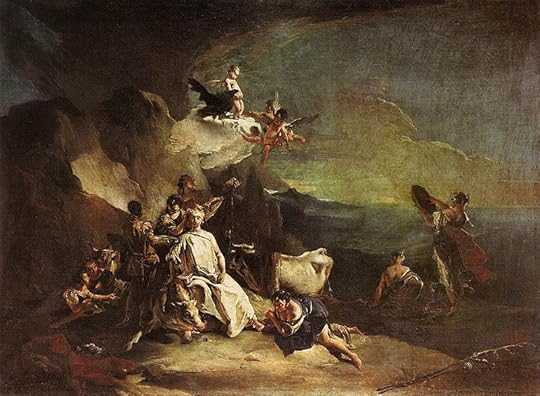
Interesting tonality... no trail of the 'pink' that struck Proust.
Tiepolo, but copy of Veronese (Dresden). ca 1743. National Galleries of Scotland.

 Roman Clodia wrote: "Haha, I *love* Atwood's The Penelopiad - it's very funny but is also aware of, and sensitive to, the scholarly criticism on the Odyssey - so certainly humourous but not, perhaps, friv..."
Roman Clodia wrote: "Haha, I *love* Atwood's The Penelopiad - it's very funny but is also aware of, and sensitive to, the scholarly criticism on the Odyssey - so certainly humourous but not, perhaps, friv..."I graduated from Victoria College in Toronto where Atwood is the local deity and where one is not allowed to regard anything that she wrote as being frivolous. In fact, in the Penelopiad she takes the same approach as Richard Armour does in his Twisted Tales from Shakespeare.
 Just a comic note.. reading yesterday something else, set in mid 18C, I run across the carriage 'Phaéton' (French text). Generally, before, I did not pay too much attention to the sort of horse-drawn carriages mentioned in books or seen in films or in museums... but of course I gave a start when I encountered the word and looked up the kind of carriage this referred to.
Just a comic note.. reading yesterday something else, set in mid 18C, I run across the carriage 'Phaéton' (French text). Generally, before, I did not pay too much attention to the sort of horse-drawn carriages mentioned in books or seen in films or in museums... but of course I gave a start when I encountered the word and looked up the kind of carriage this referred to.There are many variations; they can be for two or four seaters, but the main thing is that the carriage is very high up..
This made me smile... Phaeton seeking altitudes..
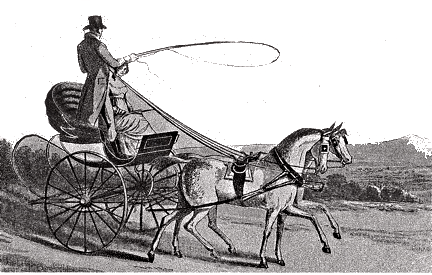
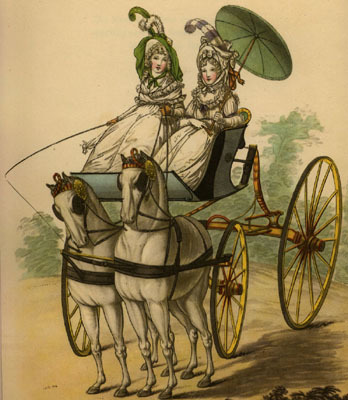
Then I also saw that VW has a Phaeton car, a plain berlina.. I wonder if that is a good name for a modern car if one cares about safety.
 Haha, I'd also not made the connection with all the phaetons we come across in Jane Austen - it's it lovely, that shiver of recognition when we find Ovid somewhere wholly unexpected? :)
Haha, I'd also not made the connection with all the phaetons we come across in Jane Austen - it's it lovely, that shiver of recognition when we find Ovid somewhere wholly unexpected? :)
 I wonder if it was a phaeton that Admiral and Mrs Croft drive around in in Austen's Persuasion? No wonder they keep tipping it over, if so!
I wonder if it was a phaeton that Admiral and Mrs Croft drive around in in Austen's Persuasion? No wonder they keep tipping it over, if so!
 Roman Clodia wrote: "I wonder if it was a phaeton that Admiral and Mrs Croft drive around in in Austen's Persuasion? No wonder they keep tipping it over, if so!"
Roman Clodia wrote: "I wonder if it was a phaeton that Admiral and Mrs Croft drive around in in Austen's Persuasion? No wonder they keep tipping it over, if so!"I pictured the vehicle as a chariot. The phaeton was very difficult to drive. They show up in most of the Georgette Heyer romances. They also are crucial to the history of parks, because they were show pieces for high society. Poor Actaeon.
 PHAETHON IN MUSIC. Here is the second of the six Symphonies after Ovid's Metamorphoses written by Carl Ditters von Dittersdorf in 1783 (see post 3/220 for further information). I don't imagine that anyone would guess the Pahaëthon theme unless told, although the first movement might be taken as an evocation of dawn, and there is certainly a lot of drama in the fourth movement, even though it ends quietly. But it would be wrong to look for blow-by-blow dramatic narrative from an 18th-century composer; if this is program music, it is much more in the manner of Vivaldi's Four Seasons than anything by Liszt or Tchaikowsky. R.
PHAETHON IN MUSIC. Here is the second of the six Symphonies after Ovid's Metamorphoses written by Carl Ditters von Dittersdorf in 1783 (see post 3/220 for further information). I don't imagine that anyone would guess the Pahaëthon theme unless told, although the first movement might be taken as an evocation of dawn, and there is certainly a lot of drama in the fourth movement, even though it ends quietly. But it would be wrong to look for blow-by-blow dramatic narrative from an 18th-century composer; if this is program music, it is much more in the manner of Vivaldi's Four Seasons than anything by Liszt or Tchaikowsky. R.https://youtu.be/F78X-UCAXyQ
 Here are two more musical Phaëthons. The first was composed in 1873 by Camille Saint-Saëns. It is an exciting piece that traces the action from its impetuous beginning to its elegiac end. The clip below has a more detailed description.
Here are two more musical Phaëthons. The first was composed in 1873 by Camille Saint-Saëns. It is an exciting piece that traces the action from its impetuous beginning to its elegiac end. The clip below has a more detailed description.https://youtu.be/IHZBSGlXkM0
The second, by Christopher Rouse, premiered in 1987. It is dedicated to the crew of the space shuttle Challenger which fell from the sky in January of the previous year. It brings a terrible modern relevance to the ancient myth, all of which is reflected in Rouse's dramatic music.
https://youtu.be/loBE5_PrHAo
 In the marvelous collection
After Ovid
(1994), there is a longish poem by the Welsh poet Glyn Maxwell titled "Phaeton and the Chariot of the Sun: Fragments of an Investigative Documentary." Its twelve sections are each in a different voice (Phaëthon, his father, his mother, a scientist, the horses, and so on), and in a different meter. I obviously can't give it all, and alas it is not online. But perhaps if I quote the first four lines and the last four, I can give some sense of the range and flavor:
In the marvelous collection
After Ovid
(1994), there is a longish poem by the Welsh poet Glyn Maxwell titled "Phaeton and the Chariot of the Sun: Fragments of an Investigative Documentary." Its twelve sections are each in a different voice (Phaëthon, his father, his mother, a scientist, the horses, and so on), and in a different meter. I obviously can't give it all, and alas it is not online. But perhaps if I quote the first four lines and the last four, I can give some sense of the range and flavor:Cine, sliver of history. A few minutes
finish you off in a blare of white, and the scutter
and scutter and sigh, then the lamp on and the smiling
that something, at least, is over.
[…]
Out of the night I will ride,
Burning bright through the eye of my father.
Watch me until I am gone,
Friend. Watch me forever, and after.
 BRITTEN'S PHAETON. In 1951, Benjamin Britten wrote a set of < i>Six Metamorphoses After Ovid< /i> for solo oboe. They are each quite short and very free, allowing the performer much latitude in telling the various stories. Here is #2, Phaeton, "who rode upon the chariot of the sun for one day and was hurled into the river Padus by a thunderbolt." With its galloping rhythm, it is splendidly energetic. Oboes don't do thunderbolts especially well, but there is no doubt whatever that Phaeton has fallen.
BRITTEN'S PHAETON. In 1951, Benjamin Britten wrote a set of < i>Six Metamorphoses After Ovid< /i> for solo oboe. They are each quite short and very free, allowing the performer much latitude in telling the various stories. Here is #2, Phaeton, "who rode upon the chariot of the sun for one day and was hurled into the river Padus by a thunderbolt." With its galloping rhythm, it is splendidly energetic. Oboes don't do thunderbolts especially well, but there is no doubt whatever that Phaeton has fallen.https://youtu.be/h4BxNcCM-ls?t=161
 Phaëthon is a very well-represented subject, as we have seen. But there are a few more I want to add. The first is a vase painting from the 5th century BCE. Since there is no specific reference to the contrary, I assume it shows the Sun god Helios, rather than his son:
Phaëthon is a very well-represented subject, as we have seen. But there are a few more I want to add. The first is a vase painting from the 5th century BCE. Since there is no specific reference to the contrary, I assume it shows the Sun god Helios, rather than his son:
Greek vase painter: The Chariot of the Sun, 5th century BCE (British Museum).
Here is a pair of engravings by Guillaume de Villenave, published in 1806; I think they are both copies of paintings by François le Barbier. I admire them for the sense of scale in the first, when Phaëthon is still riding high, but things are just beginning to go wrong (perhaps the influence of that Scorpio in the sky), and the totality of the destruction in the second:

Villenave: Phaëthon and the Horses of the Sun, 1806.

Villenave: The Fall of Phaëthon, 1806.
And finally a sculpture by Dominique Lefevre, from the early 18th century. Once again I am struck by the potential of the three-dimensional form to enhance the pathos of such a subject as compared to a painted image:

Lefevre: The Fall of Phaëthon, 1700–11 (London, V&A)
 Continuing the Phaëthon story and filling in one last gap: Cycnus and the Heliades, the mourners of the fallen boy. Here is an etching by Johann WIlhelm Baur that tells the story quite clearly:
Continuing the Phaëthon story and filling in one last gap: Cycnus and the Heliades, the mourners of the fallen boy. Here is an etching by Johann WIlhelm Baur that tells the story quite clearly:
Baur: The Sisters of Phaëthon Turn into Trees, etching, c.1639.
And here, more colorful but harder to make out, is a tapestry by Jean Baudouyn after a design by Giulio Romano. The details below show the Heliades turning into poplars on the left, and Cycnus at the extreme right.

Giulio Romano: The Heliades, mid-C16. Tapestry by Jean Baudouyn (Ecouen).
 I was yesterday in the Prado gift shop and found they were selling this bag...
I was yesterday in the Prado gift shop and found they were selling this bag...
Then I saw they also had the print. They don't know who drew it.

 I the Thyssen there is this other Europa. Clearly following the Veronese formula..
I the Thyssen there is this other Europa. Clearly following the Veronese formula.. The French Simon Vouet. Circa 1640.
I took the photos.

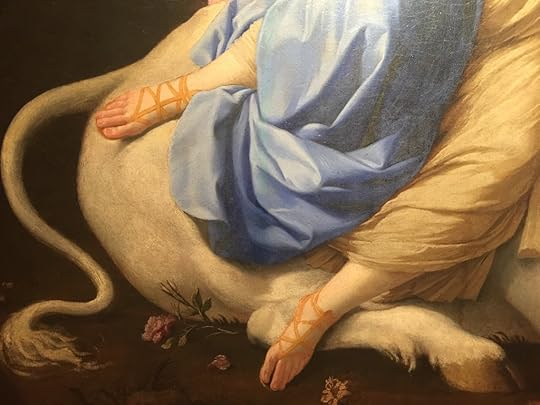
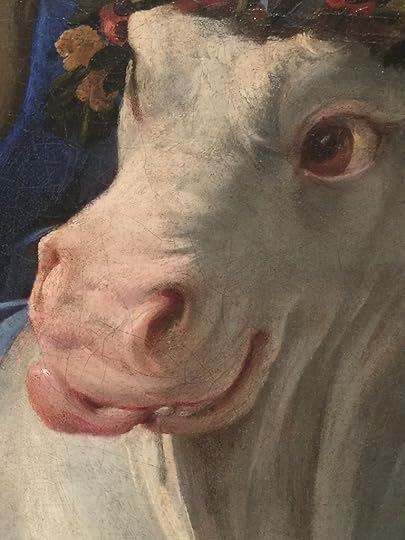
Haha... that gloating and smug Jupiter.. drooling...
 Those details you took are great, Kalliope; I like them more than the picture as a whole. What is the origin and concentration of the Thyssen, as opposed to the Prado? Like the Wallace Collection to the London National Gallery, or the Isabel Stewart Gardiner in Boston? R.
Those details you took are great, Kalliope; I like them more than the picture as a whole. What is the origin and concentration of the Thyssen, as opposed to the Prado? Like the Wallace Collection to the London National Gallery, or the Isabel Stewart Gardiner in Boston? R.
 Kalliope wrote: "To depict Phaeton's fall is a great challenge and Rubens, unsurprisingly, felt he could meet it..
Kalliope wrote: "To depict Phaeton's fall is a great challenge and Rubens, unsurprisingly, felt he could meet it..Rubens. Fall of Phaeton. 1606-8. Washington National Gallery.
We see Phaeton drawing an arc whi..."
the terror comes through, despite the very small scale of the screen
 The descriptions of Envy are riveting. Teeth black with rust; breast green with gall; tongue dripping venom; seeing success she pines away with sorrow. She both torments and is tormented at the same moment, forever her own punishment.
The descriptions of Envy are riveting. Teeth black with rust; breast green with gall; tongue dripping venom; seeing success she pines away with sorrow. She both torments and is tormented at the same moment, forever her own punishment. It's a nightmare vision. Are there any images you know of, Kalliope, that picture Aglauros in the grip of Envy?
 Roger wrote: " What is the origin and concentration of the Thyssen, as opposed to the Prado? Like the Wallace Collection t..."
Roger wrote: " What is the origin and concentration of the Thyssen, as opposed to the Prado? Like the Wallace Collection t..."There is no connection between the two museums other than being across the street from each other. The Thyssen was originally the private collection of the two Barons Thyssen-Bornemisza. It is an admirable collection given that it was begun quite late. The older Baron liked the 'Old School' and the younger one expanded the 'Modern School'. The collection was deposited in Madrid for a ten year period at the end of which the country purchased it in block.
It complements the Prado very nicely - the way both grew is so entirely different.
 Lyn wrote: "The descriptions of Envy are riveting. Teeth black with rust; breast green with gall; tongue dripping venom; seeing success she pines away with sorrow. She both torments and is tormented at the sam..."
Lyn wrote: "The descriptions of Envy are riveting. Teeth black with rust; breast green with gall; tongue dripping venom; seeing success she pines away with sorrow. She both torments and is tormented at the sam..."I agree, Lyn.. the description of Envy is fabulous...
I think I already posted something on Envy.. I will look for it
Meanwhile I also found this - interesting because of the poor Fabritius we normally only know his Goldfinch.
Not quite what your are looking for, Lyn... for Fabritius has chosen a suspended moment before and after anything happens... Mercury is 'about to' turn Aglauros into stone.
Carel Fabritius. About 1645-47. Boston Fine Arts.

But the best depiction of Envy, although not in an Ovidian context, is Giotto's in the Scrovegni chapel.

 Thank you Kalliope. I am curious to see how artists might have represented envy from that description. The Fabritius is a fascinating painting, and I wonder if the small, mean- looking figure at Athena/Minerva’s feet represents envy. I love Mercury’s combination of elaborate 17th century clothing and bare feet with golden wings.
Thank you Kalliope. I am curious to see how artists might have represented envy from that description. The Fabritius is a fascinating painting, and I wonder if the small, mean- looking figure at Athena/Minerva’s feet represents envy. I love Mercury’s combination of elaborate 17th century clothing and bare feet with golden wings.
 Roger wrote: "Phaëthon is a very well-represented subject, as we have seen. But there are a few more I want to add. The first is a vase painting from the 5th century BCE. Since there is no specific reference to ..."
Roger wrote: "Phaëthon is a very well-represented subject, as we have seen. But there are a few more I want to add. The first is a vase painting from the 5th century BCE. Since there is no specific reference to ..."The sculpture is wonderful.
 The Giotto didnt come up at first. Yes, it is brilliant. Thank you again. It's wonderful to have all these images coming through.
The Giotto didnt come up at first. Yes, it is brilliant. Thank you again. It's wonderful to have all these images coming through.
 EUROPA OPERAS? Slim pickings here, I'm afraid, or rather two near misses.
EUROPA OPERAS? Slim pickings here, I'm afraid, or rather two near misses.1. L'Europa, "opera prologue in one act" by Alessandro Melani (1667). I came upon this only through this advertisment for a production at Potsdam last summer. The describe it as a Barockoper mit göttlichem Brautraub, or "Baroque Opera with Godly Bride-Theft," so at least it deals with the central action. But it appears to be simple, with only the two main characters and a narrator, and it is short. I can find out nothing more about it, and precious little on the composer.
2. Europa riconosciuta, ("Europa Revealed") by Antonio Salieri (1776). This is a significant work in operatic history, as it was the inagural production at La Scala, and revived when the theatre re-opened in 2004 after a three-year closure. However, beyond the fact that two of its characters are called Europa (that Europa) and Semele (but not that Semele), its plot has nothing to do with Ovid. The 2004 revival is on YouTube in sound only, and there are a few quite good clips, some with English titles. It is clearly a big serious opera, with long arias of daunting virtuosity, much as you find, say, in Mozart's Idomeneo or La clemenza di Tito.
• Sound recording (complete)
• Aria for Europa
• Aria for Semele
• Scene for Semele and Isseo
• Ballet
 Looking through the Paul Barolsky just now, I came upon another painting of the story of Mercury, Aglauros, and Herse that I should have known (because it's in Cambridge, and I got my art history degree from there), but had forgotten:
Looking through the Paul Barolsky just now, I came upon another painting of the story of Mercury, Aglauros, and Herse that I should have known (because it's in Cambridge, and I got my art history degree from there), but had forgotten: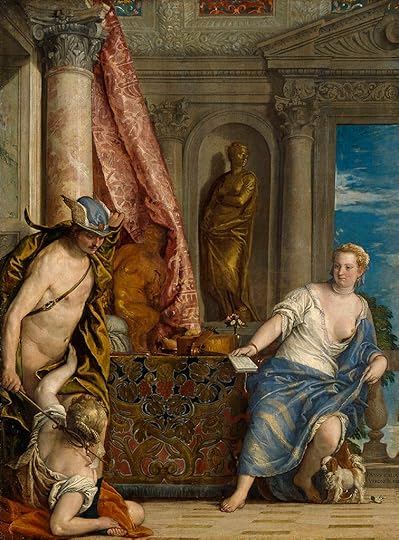
Veronese: Mercury, Aglauros, and Herse (1576–84, Cambridge UK)
Veronese chooses the moment just before the touch of Mercury's wand turns the jealous Aglauros to stone. He has perfectly caught Ovid's description of her crouching at the door trying to prevent the entrance of the god:
At length before the door her self she cast;The Fitzwilliam Museum has a close explanation of the picture, with tiny thumbnails, each of which can be opened up to show a telling detail; it is worth a look:
And, sitting on the ground with sullen pride,
A passage to the love-sick God deny'd.
The God caress'd, and for admission pray'd,
And sooth'd in softest words th' envenom'd maid.
In vain he sooth'd: "Begone!" the maid replies,
"Or here I keep my seat, and never rise."
"Then keep thy seat for ever," cries the God,
And touch'd the door, wide op'ning to his rod.
Fain would she rise, and stop him, but she found
Her trunk too heavy to forsake the ground…
https://www.fitzmuseum.cam.ac.uk/phar...
 I have just received a music magazine to which I am subscribed, and on the back cover there is an add for
I have just received a music magazine to which I am subscribed, and on the back cover there is an add forCavalli's La Calisto.
I will consider purchasing tickets.
https://www.teatro-real.com/en/season...
 Kalliope wrote: "I have just received a music magazine to which I am subscribed, and on the back cover there is an add for
Kalliope wrote: "I have just received a music magazine to which I am subscribed, and on the back cover there is an add forCavalli's La Calisto.
I will consider purchasing tickets."
Oh, don't consider; call the theater now! It is a great, great opera, melodious, touching, and very funny all at the same time. And you are to have a splendid cast (both casts, actually).
I would not have associated the stage director, David Alden, with baroque opera, and there is the possibility that this may all be way over the top. But Calisto is an opera that can take it, because the basic material is so very, very good.
For a musical sampler, without prejudicing you in any way as to the staging, look at this lovely recording-session video of Calisto's first aria, sung by the lovely Nuria Rial. Watching it again makes sad to realize that the thing I will miss most in retirement is working with baroque musicians such as these! R.
https://youtu.be/H2Ks_TurCUo
 Roger wrote: "Oh, don't consider; call the theater now
Roger wrote: "Oh, don't consider; call the theater now..."
Thank you for the recommendation.. I will look into the tickets. I am no great fan of Teatro Real. It is small, so the tickets are frightfully expensive even with poor sitting, and the productions are not always a success.
But I will investigate.
 Roger wrote: "Kalliope wrote: "I have just received a music magazine to which I am subscribed, and on the back cover there is an add for
Roger wrote: "Kalliope wrote: "I have just received a music magazine to which I am subscribed, and on the back cover there is an add forCavalli's La Calisto.
."
Thank you so much, Roger for this little gem! I must have re-played it half a dozen times. Irresistible music!
 It is, Jim, isn't it?! I hope that influenced your decision too, Kalliope.
It is, Jim, isn't it?! I hope that influenced your decision too, Kalliope. Maybe I should have said that, in the opera, this is simply sung; the opening verse featuring the cornetto was added by the arranger, although the instrument is perfectly in period. One of the joys of early music is that it adapted to the forces available, so you can do these things; there is a lot of room for improvisation. R.
Books mentioned in this topic
Le bain de Diane (other topics)After Ovid: New Metamorphoses (other topics)
The Penelopiad (other topics)
Metamorphica (other topics)
The Penelopiad (other topics)
More...
Authors mentioned in this topic
Pierre Klossowski (other topics)Euripides (other topics)





Which doesn't prevent one from enjoying them as pictures, especially the beautiful balance of the Minderhout, as you say. R.